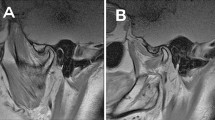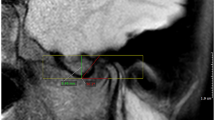Abstract
Aim
The aim of this study was to investigate possible correlation of specific skeletal or dental class in children and adolescents with clinical signs of temporomandibular dysfunction (TMD) with the severity of internal derangement (ID) of the temporomandibular joint.
Materials and methods
Based on MRI images, the ID of 232 juvenile temporomandibular joints in 116 patients were retrospectively recorded. The distribution of the ID stages within the skeletal and dental classes was compared by means of the χ 2 test.
Results
Excluding the comparison between skeletal Class I (S I) and skeletal Class II (S II; p < 0.05), no statistically significant differences in the distribution of the ID stages were found between the skeletal classes (p > 0.05). No statistically significant differences were found when comparing the distribution of the ID stages between the dental classes (p > 0.05).
Conclusion
According to these findings, there is no skeletal or dental class that is related to higher degrees of internal derangement in the TMJs of children and adolescents presenting clinical signs of TMD. Therefore, it is not possible to draw conclusions about the severity of the ID in relation to the dental and skeletal class in symptomatic juvenile TMJs.
Zusammenfassung
Ziel
Ziel der Studie war es zu untersuchen, ob es bereits bei Kindern und Jugendlichen, die ein klinisches Zeichen für eine temporomandibuläre Dysfunktion (TMD) zeigten, eine bestimmte skelettale oder dentale Klasse gibt, die sich durch höhere Schweregrade bezüglich eines Internal Derangement (ID) auszeichnet.
Material und Methode
Auf der Basis von MRT(Magnetresonanztomographie)-Aufnahmen wurde retrospektiv von 232 juvenilen Kiefergelenken, also 116 Patienten mit einer temporomandibuläen Dysfunktion, das ID erfasst. Mittels des χ 2-Tests wurde die Verteilung der ID-Stadien innerhalb der skelettalen und dentalen Klassen verglichen.
Ergebnisse
Mit Ausnahme des Vergleichs zwischen der skelettalen Klasse I (S I) und der skelettalen Klasse II (S II; p < 0,05) wurden keine statistisch signifikanten Unterschiede in der Verteilung der ID-Stadien innerhalb der skelettalen Klassen festgestellt (p > 0,05). Im Vergleich der Verteilung der ID-Stadien zwischen den dentalen Klassen wurde kein statistisch signifikanter Unterschied festgestellt (p > 0,05).
Schlussfolgerung
Basierend auf diesen Ergebnissen zeichnet sich keine skelettale oder dentale Klasse aus durch vermehrt höhere Schweregrade eines Internal Derangement in juvenilen Kiefergelenken, die klinische Anzeichen einer TMD aufweisen. Folglich ist es nicht möglich, Rückschlüsse auf den Schweregrad des Internal Derangement in symptomatischen juvenilen Kiefergelenken in Abhängigkeit von der skelettalen und dentalen Klasse zu ziehen.





Similar content being viewed by others
References
Angle EH (1899) Classification of malocclusion. Dent Cosmos 41:248
Angle EH (1913) Die Okklusionsanomalien der Zähne. Meusser, Berlin
Ahlers OM, Freesmeyer W, Götz G (2003) Instrumentelle, bildgebende und konsiliarische Verfahren zur CMD-Diagnostik. In: Wissenschaftliche Stellungnahme der deutschen Gesellschaft für Zahn- Mund- und Kieferheilkunde. Düsseldorf
Brooks SL, Westesson PL, Eriksson L et al (1992) Prevalence of osseous changes in the temporomandibular joint of asymptomatic persons without internal derangement. Oral Surg Oral Med Oral Pathol 73:122–126
Cohen J (1988) Statistical power analysis for the behavioral sciences, 2nd edn. Lawrence Erlbaum, Hillsdale
Daif ET (2012) Role of intra-articular ozone gas injection in the management of internal derangement of the temporomandibular joint. Oral Surg Oral Med Oral Pathol Oral Radiol 113:e10–e14
De Leeuw R, Boering G, Stegenga B et al (1995) TMJ articular disc position and configuration 30 years after initial diagnosis of internal derangement. J Oral Maxillofac Surg 53:234–241
Drace JE, Enzmann DR (1990) Defining the normal temporomandibular joint closed-, partially open-, and open-mouth MR imaging of asymptomatic subjects. Radiology 177:67–71
Dworkin SF, Le Resche L (1992) Research diagnostic criteria for temporomandibular disorders: Review, criteria, examinations and specifications, critique. J Craniomandib Disord. 6:301–355
Egermark-Eriksson I, Carlsson GE, Magnusson T, Thilander B (1990) A longitudinal study on malocclusion inrelation to signs and symptoms of cranio-mandubular disorders in children and adolescents. Eur J Orthod 12:399–407
González-García R, Rodríguez-Campo FJ (2011) Arthroscopic lysis and lavage versus operative arthroscopy in the outcome of temporomandibular joint internal derangement: a comparative study based on Wilkes stages. J Oral Maxillofac Surg 69:2513–2524
Greene CS, Laskin DM (1988) Long-term status of TMJ clicking in patients with myofascial pain and dysfunction. J Am Dent Assoc 117:461–465
Isberg A, Hägglund M, Paesani D (1998) The effect of age and gender on the onset of symptomatic temporomandibular joint disk displacement. Oral Surg Oral Med Oral Pathol Oral Radiol Endod 85:252–257
Kahl-Nieke B (2010) Einführung in die Kieferorthopädie. Deutscher Zahnärzte Verlag, Köln
Kinzinger GS, Roth A, Gülden N et al (2006) Effects of orthodontic treatement with fixed functional orthopaedic appliances on the condyle- fossa relationship in the temporomandibular joint: an MRI study (part I). Dentomaxillofac Radiol 35:339–346
Kinzinger GS, Roth A, Gülden N et al (2006) Effects of orthodontic treatement with fixed functional orthopaedic appliances on the condyle- fossa relationship in the temporomandibular joint: a MRI study (part II). Dentomaxillofac Radiol 35:347–356
Larheim TA (2005) Role of magnetic resonance imaging in the clinical diagnosis of the temporomandibular joint. Cells Tissues Organs 180:6–21
Larheim TA, Westesson PL, Sano T (2001) Temporomandibular joint disk displacement: comparison in asymptomatic volunteers and patients. Radiology 218:428–432
Lundh H, Westesson PL, Kopp S (1987) A three year follow-up of patients with reciprocal temporomandibular joint clicking. Oral Surg Oral Med Oral Pathol 63:530–533
Musgrave MT, Westesson PL, Tallents RH et al (1991) Improved magnetic resonance imaging of the temporomandibular joint by oblique scanning planes. Oral Surg Oral Med Oral Pathol 71:525–528
Paesani D, Westesson PL, Hatala MP et al (1992) Accuracy of clinical diagnosis for TMJ internal derangement and arthrosis. Oral Surg Oral Med Oral Pathol 73:360–363
Paesani D, Westesson PL, Hatala M et al (1992) Prevalence of temporomandibular joint internal derangement in patients with craniomandibular disorders. Am J Orthod Dentofacial Orthop 101:41–47
Paesani D, Salas E, Martinez A, Isberg A (1999) Prevalence of temporomandibular joint disc displacement in infants and young children. Oral Surg Oral Med Oral Pathol Oral Radiol Endod 87:15–19
Pullinger AG, Seligman D (1987) TMJ osteoarthrosis: a differentiation of diagnostic subgroups by symptom history and demographics. J Craniomandibular Disord 1:251–256
Santos KC, Dutra ME, Warmling LV, Oliveira JX (2013) Correlation among the changes observed in temporomandibular joint internal derangements assessed by magnetic resonance in symptomatic patients. J Oral Maxillofac Surg 71:1504–1512
Segner D, Hasund A (1998) Individualisierte Kephalometrie. Segner, Hamburg
Selaimen CM, Jeronymo JC, Brilhante DP et al (2007) Occlusal risk factors for temporomandibular disorders. Angle Orthod 77:471–477
Simmons HC, Oxford DE, Hill MD (2008) The prevalence of skeletal class II patients found in a consecutive population presenting TMD treatment compared to the national average. J Tenn Dent Assoc. 88:16–18
Tasaki MM, Westesson PL (1993) Temporo-mandibular joint: diagnostic accuracy with sagittal and coronal MR imaging. Radiology 186:723–729
Tomas X, Pomes J, Berenguer J et al (2006) MR Imaging of temporomandibular joint dysfunction: a pictorial review. Radiographics 26:765–781
Vogl TJ, Eberhard D (1993) MR-Tomographie Temporomandibulargelenk. Thieme, Stuttgart, pp 61–66
Wilkes CH (1989) Internal derangement of the temporomandibular joint. Arch Otolaryngol Head Neck Surg 115:469–477
Author information
Authors and Affiliations
Corresponding author
Ethics declarations
Conflict of interest
S. Stein, A. Hellak, N. Popović, D. Toll, M. Schauseil, and A. Braun state that they have no competing interests.
This article does not contain any studies with human participants or animals performed by any of the authors.
Additional information
Dr. med. dent. Steffen Stein.
Rights and permissions
About this article
Cite this article
Stein, S., Hellak, A., Popović, N. et al. Internal derangement in the temporomandibular joint of juveniles with clinical signs of TMD. J Orofac Orthop 78, 32–40 (2017). https://doi.org/10.1007/s00056-016-0068-7
Received:
Accepted:
Published:
Issue Date:
DOI: https://doi.org/10.1007/s00056-016-0068-7
Keywords
- Magnetic resonance imaging
- Temporomandibular joint dysfunction syndrome
- Skeletal class
- Dental class
- Internal derangement




